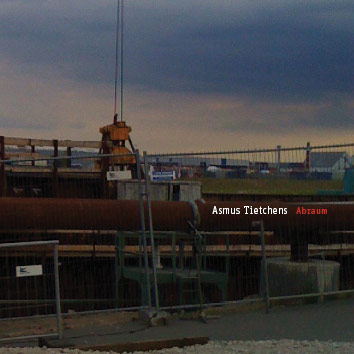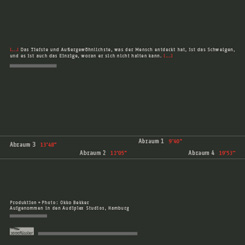

ASMUS TIETCHENS
Abraum
CD, (56:22 min), 300 copies, cardboard cover
1000füssler 017, release date: 27th october 2010
- sold out - (please check our distributors)
A new subway tunnel is being built in the harbor area of Hamburg's inner city. The tunneling produces waste and the waste needs to be disposed of. In this case sand and shredded rubble are mixed with groundwater in order to be pumped out through steel tubes with a diameter of approximately 80cm. The sounds that are produced in the tubes are object of field recordings that I made at different times and places on site. It was immediately apparent that the continuum of the basic sounds that I used for my compositions already sounded formed in its randomness and diversity. The real surprise though, was that commonplace noises such as flowing water and rippling sand were completely inaudible, instead a steady progression of sophisticated rasping and quiet metal jangling was present. Besides the polymorphism of the basic sounds it was the total artificiality of the signal that interested me, acoustic manifestations of sand and water subject to the conditions of technical and functional canalization. Asmus Tietchens
Abraum 3 13'48" (excerpt at soundclud)
Abraum 2 12'05" (excerpt at soundcloud)
Abraum 1 09'40"
Abraum 4 19'53"
Aufgenommen in den Audiplex Studios, Hamburg. Produktion + Photo: Okko Bekker.
About the Artist:
Asmus Tietchens lives and works in Hamburg. His focus is on the manipulation of sounds in ways suggested by the material itself. In 1965 he began to experiment with tape machines, concrete sounds and electronic sound generators. After a period of experimental pop music at the beginning 1980, he became more and more influenced by Industrial Music (1982 -1985). Since the mid 1990s his music is characterized by a reductionist aesthetic, often using sine waves, white noise and quiet sounds.
Until today more than 50 LP- and CD-releases as well as numerous public performances in Germany and abroad. Collaborations with Thomas Köner (Kontakt der Jünglinge), Achim Wollscheid, Jon Mueller, Arcane Device, Richard Chartier, Merzbow and many others. 2003 and 2006 awarded with the "Karl-Sczuka-Preis für Akustische Kunst" by German public radio station SWR. Guest lecturer for sound studies at the Hamburg University of Applied Sciences (1989-2010) and the University of Fine Arts of Hamburg (2010).
www.tietchens.de
REVIEWS:
Paris Transatlantic / France
"Those streets in Tokyo, those rainforests.. we've heard them so many times," sighs Asmus Tietchens, bemoaning the omnipresence of field recordings in electronic music today. But it seems he's joined the club himself with Abraum, which is sourced exclusively from sounds recorded at a building site in his home town Hamburg, mostly "sand and shredded rubble [..] mixed with groundwater [and] pumped out through steel tubes with a diameter of approximately 80cm". I love that last detail – a typical touch of Tietchens precision. Abraum's use of field recordings marks something of a change for the composer, who's normally a fervent champion of "pure" Elektronische Musik (he grew up listening to Stockhausen and Koenig on the radio.. howzat for childhood epiphany?), but don't be fooled: the concrete sounds have been extensively transformed with Tietchens' customary attention to detail. And even when a raw source appears – a clank, here, a rustle there – it often sounds as abstract and complex as its processed neighbours. Asmus Tietchens is definitely one of The Inscrutables, along with his erstwhile collaborators Thomas Köner and Richard Chartier: don't expect any brightly lit road signs as you journey through this music. There's no GPS to help you either: this is a path you have to make and take by yourself.
Dan Warburton / Paris Transatlantic, Yule 2010
Vital Weekly / Netherlands
The work of Asmus Tietchens becomes more and more radical. I have no idea how things work on 'Abraum', but its most likely one of the more stranger Tietchens works. Apparently somewhere in Hamburg, where Tietchens lives, there is a tunnel being made in the harbor. As far as I understand Tietchens went there to do some recording, which he brought in the studio. So far nothing new, but the 'problem' is that we don't know what he did in the studio. His usual kind of processing only seems to be appearing in 'Abraum 4', the final piece on 'Abraum'. The microscopic, detailed splatter of sound, being fed through oscillators make a connection of Tietchens's imminent past. But in the first three pieces this seems to be not the case. They seem (but no doubt I am wrong) be cut straight from a bunch of field recordings, and hardly sound processed at all. But it is a composition (three of them) in as far that Tietchens collects the very silent bits with a minimum of sound information and collates these together into some very intense music. One needs his full attention to pick up what this is about. No sit back and lie down music, but some seriously intense form of soundscaping. Highly - neh utterly - reduced in its form but with an absolute great musical quality. I am biassed, I know - I just happen to like Tietchens a great and this new CD is one of the most radical and pure releases by him.
Frans de Ward / Vital Weekly 755
IEM / Russia
Whatever quality and possibilities the advanced studio can have, any random outdoor sounds may deliver some immense reflections and transcend all the best results of musicians who took a lot of time sitting in the closed room that is their workplace. This is the message told us by sound artists working with phonography, occasional field recordings and natural soundscapes. As you probably know, Asmus Tietchens got involved in experimental music scene by collecting the sounds on his taperecorder just like the diary many years ago, but recently changed his approach many times, ended with something so far from initial attitude. His latest albums are pure studio trickery. But with this album, you will be surprised - most part of it was recorded in sewage tunnel near the old Hamburg harbour. Tietchens says that with this album he want to trace the relations between acoustic qualities of the sound and pure technical aspects, functionality of the objects producing sounds. What we have here it's four long tracks, all untitled, made of raw recordings in the tunnel and constructed in the studio afterwards. Absolutely distinct sound, which is not typical neither for other Titchens' albums nor for the whole genre. But the trademark approach is always present: subtle and careful work with microscopic sonic artifacts, detailed and abstract matter affording the concentrated and patient listening skills.
Dmitry Vasilyev / IEM webzine
le son du grisli / France
Jonas ou, plus près de nous, Pinocchio, auraient-déjà fait l’expérience de l’antre de la bête et de s’y promener en attendant d’être recraché… Et c’est une belle expérience, nous dit Asmus Tietchens, quelle que soit la bête. La sienne est un tunnel en construction à Hambourg où il a enregistré des sons.
Un liquide qui semble tomber sur une bâche en plastique par exemple. Comme Tietchens mérite notre confiance nous le suivons dans des tubes où de l’eau draine des grains de sable, où des coups sont donnés sur le matériau, où les bruits des résidus sont captés par des micros que la sensibilité transforme en exclamations : crics et cracs de temps en temps sont en cadence et c’est comme ça que l’on suit la progression du chantier. Les bruits sont de plus en plus nombreux et ilsd prouvent que le tunnel est bientôt prêt. Asmus Tietchens a raconté sa construction en moins d’une heure, le temps d’écrire une symphonie plus qu'originale.
Héctor Cabrero / le son du grisli, December 2010
Bad Alchemy / Germany
In Hamburgs Hafengegend wurde ein neuer U-Bahn-Tunnel gegraben, und ASMUS TIETCHENS war mit dem Mikrophon vor Ort, um Geräusche des abgepumpten Sands, Schlicks und Grundwassers aufzunehmen. Zu seiner Verwunderung trug dieser Geräuschfluss bereits seine Handschrift, bevor er im Studio Hand angelegt hatte. Als reichhaltig und von hohem Random-Faktor erwies sich schon das Basismaterial selbst. Typischer Sand- und Wasserklang war dagegen kaum zu vernehmen. Abraum (1000füssler 017) bekommt aber doch noch den Tietchens-Touch, indem er das Basismaterial unters Elektronenmikroskop legt. So erklingt nun ‚nur‘ ein Kratzen und Klackern, Zischeln und Kullern, wie es speziell für Tietchens Hydrophonien charakteristisch ist. Auffällig ist in der Verkleinerung das überproportionale Detail. Aus U-Bahn-Bau und Materialverschiebungen en gros wird ein geisterhaftes Klickern, Knistern oder Glucksen. Ganz selten meint man doch noch einen kleinen Kiesel ein Rohr entlang springen zu hören. Viele Passagen ähneln Seancen mit hintergründig hantierenden Poltergeistern. Aber insgesamt scheint Tietchens aus dem Gedankensplitter, den er - wie immer - bei E.M. Cioran fand, seine Konsequenz gezogen zu haben: Das Tiefste und Außergewöhnlichste, was der Mensch entdeckt hat, ist das Schweigen, und es ist auch das Einzige, woran er sich nicht halten kann. Dass er sich beinahe daran hält, seine Reductio ad profundis, räumt Gewohntes und Gewöhnliches ab. Was bleibt?
Rigo Dittmann / Bad Alchemy 68
www.1000fussler



